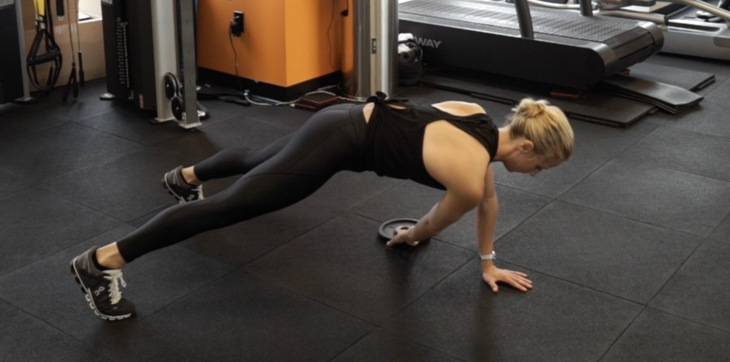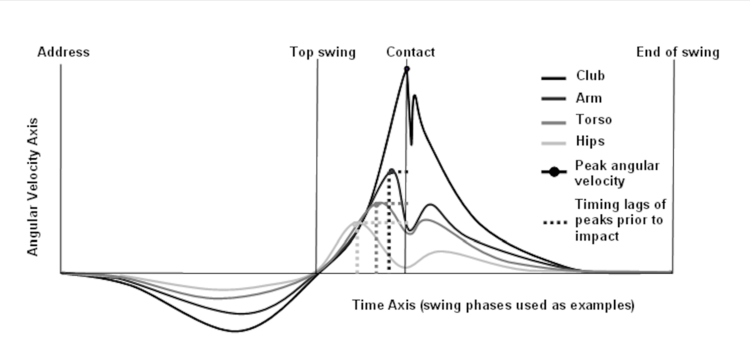IMPROVE MY GAME
Articles
7 Anti-Rotation Exercises to Maximize Clubhead Speed

By Dr Ben Langdown and Jennifer Fleischer
@BenLangdown @HolisticFitSF
Dr. Ben Langdown is a presenter at the 2018 World Golf Fitness Summit. His topic is Exploring the Impact of Habits and Volumes on Golfer’s Yards and Years
Anti-rotation. As a golfer you may be thinking, why would I want to resist rotation when my sport demands so much of it? It sounds counterproductive, right? Whether you're looking to increase your clubhead speed, reduce the risk of injury around the lower back or just increase your strength and tone through the core muscles, training for anti-rotation is key.
Why? Because anti-rotation training helps golfers create a more efficient transfer of force from the ground up through the body and out to the clubhead. Recent research has demonstrated, once again, that the ground is our friend in golf. Amongst other significant results, Wells et al., (2018) reported that the greater the peak force a golfer can press into the ground during an isometric mid-thigh pull (a test they used to measure this force), the greater the clubhead velocity is likely to be. This data is significant when considering the transfer of force up through the body in the golf swing. If you are generating high ground reaction forces then you certainly don’t want any leaking out of the system unnecessarily just because you didn’t do the right training in the gym, or didn’t even see the benefit of training in the first place!
Many of you will have heard the terms kinetic chain and kinematic sequence before. For those of you who are new to these terms, they refer to the sequential transfer of force and movements respectively from the ground upwards, through the pelvis, trunk, arms and ultimately ending up with as much speed as possible in the clubhead as it travels through impact with the golf ball.
Ground reaction forces drive the following sequence:
‘Pelvic Rotation – Trunk Rotation – Arm Action – Impact between clubhead and golf ball’ (Figure 1).
It’s as simple as cracking a whip! Speed one section up, slow it down rapidly to transfer the energy to the next section until the end of the sequence results in maximal angular velocity.

Figure 1 A Model of an Ideal Kinematic Sequence for a Golf Swing, Highlighting 4 Body Segments: Hips, Shoulders (Trunk), Wrists and Clubhead (Langdown et al., 2012).
However, what’s possibly more important than generating the ground reaction forces is to block the leaks higher up the chain – so, in between the pelvis reaching its top speed and the trunk then taking over, we need the ability to transfer this force through the rapid deceleration of the pelvis. Then, just as we want the arms to take over the trunk needs to rapidly decelerate and so on until we crack the whip – the clubhead impacting with the ball.
So, although it may seem counterintuitive to train to resist rotation, doing just this (i.e. anti-rotation training) allows golfers to increase the strength of the muscles that generate this rotation and deceleration in their swing.
Note: we are not saying rotation based exercises are to be forgotten – but you should look to incorporate both rotation and anti-rotation into your golf strength and conditioning programme. Rotation exercises should be focussed on the thoracic region of the spine and the hips – not through the lumbar region as this is designed for stability – not rotational mobility.
What better place to start to train anti-rotation than with some Pallof Press exercises. The following can all be performed with a cable machine or resistance band:
Note: for all of the exercise suggestions you should ensure you have 2-3 minutes rest between sets – or use supersets where you switch to another exercise focusing on the opposing muscles in between.
Exercise 1: Kneeling Pallof Press
Sets and reps suggestion: Try adding 2 sets x 12 reps each side to begin with into your programme.
Coaching points: Select a resistance that challenges you but allows you to maintain form and anti-rotation. Keep the trunk and pelvis square throughout the movement. Do the exercise slowly while bracing through the core. Push the hands out along a straight path before returning them slowly toward the body.
Half kneeling or split-stance positions are great ways to increase the challenge and keep your training progressive:
Exercise 2: Split Stance Pallof Press
Sets and reps suggestion: Again, 2 x 12 each side to begin.
Coaching points: Again, select a weight that challenges you but allows you to keep your body upright and trunk and pelvis aligned square to the cable. Push the hands out along a straight path before returning them slowly toward the body.
Further progressions with these can be achieved through the raising of the hands overhead while continuing to keep the rest of the body aligned.
Exercise 3: Standing Pallof Press with Overhead Cable Raise
Sets and reps suggestion: 2 x 12 each side.
Coaching points: Maintain a square body position throughout and ensure you don’t extend through the back as you raise the arms overhead. Keep the hands directly in line with the body throughout without the cable pulling them back towards the stack.
The following exercises are floor based using variations of the plank to allow progression and overload to the anti-rotation focus of any programme.
Exercise 4: Plank Plate Slide
Sets and reps suggestion: Try adding 4 x 5 slides to each side to begin.
Coaching points: Adding the slide to the plank allows you to test your ability to maintain the body’s position while performing a movement with the arms. It essentially becomes a single arm plank position. Brace through the core and keep a neutral pelvis and spine throughout.
Exercise 5: Renegade Rows with DBs
Sets and reps suggestion: Try adding 4 x 5 rows to each side to begin.
Coaching points: Select a weight that will challenge you but also allow good form to be maintained throughout. This exercise is about maintaining the body’s position while performing the row.
Exercise 6: Plank Up Downs
Sets and reps suggestion: Try adding 2-4 sets of 30 seconds for this exercise.
Coaching points: As you move up and down through the reps try to keep your trunk and pelvis as still as possible – widening the feet can allow more stability at the pelvis.
Exercise 7: Plank Single-Arm Cable Row
Sets and reps suggestion: Try adding 4 x 5 rows to each side to begin.
Coaching points: Select a weight that is challenging but allows you to keep your pelvis and trunk aligned throughout.
In our next article we will show you more dynamic movement based exercises to add into your programme for stability and strength in the legs, glutes and trunk and shoulders – the key areas of transferring force through the kinetic chain!
Past Articles from Dr. Ben Langdown and Jennifer Fleischer:
8 Exercises to Improve your Scapula Stability and Shoulder Mobility for Golf
5 Exercises for Increasing Thoracic Spine Mobility in Your Golf Swing
Four Exercises for Stronger, More Powerful Glutes

Dr. Ben Langdown was head of Sports Science at The PGA National Training Academy at The Belfry for over 10 years and is now lecturing and researching in Sports Coaching at The Open University (@OU_Sport). Alongside this Ben works with many elite amateur and professional golfers providing strength and conditioning support. Ben has a PhD in the field of golf biomechanics, studying movement variability and strength and conditioning for golf. Having previously presented research on golf swing centre of pressure displacement and warm-up protocols at two previous WGFS, his most recent research has focused on the relationships between physical screening and 3D golf swing kinematics. Follow Ben at @BenLangdown.

Jennifer Fleischer is the founder of Holistic Fitness San Francisco, a wellness consulting company that offers Golf Fitness Training, Strength and Conditioning Programs and Integrative Nutrition Coaching. She is a Level 3 Titleist Performance Institute Certified Golf Fitness Instructor. Follow Jennifer at @HolisticFitSF.
References: